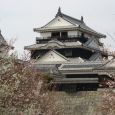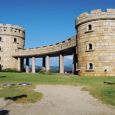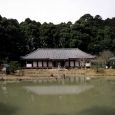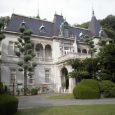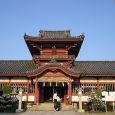Matsuyama
Advertisement
By plane
Matsuyama Airport Nonstop service from major airports such as Tokyo Haneda, Nagoya Komaki, Osaka Itami and Fukuoka, as well as from Okinawa. There are also direct flights to and from Seoul and Shanghai. The Limousine Bus connects the airport to Dogo Onsen, running at 20 minute intervals (¥450) via JR Matsuyama Sta (¥300).
By train
Matsuyama is on the JR Yosan Line. From the mainland, take the San'yo Shinkansen to Okayama, and transfer to the Shiokaze Limited Express, which will get you to Matsuyama in about three hours (¥6630).
The Ishizuchi Limited Express connects Matsuyama with Takamatsu on the eastern end of Shikoku (2 1/2 hours, ¥6010). The Uwakai and a few other limited express services run to Uwajima (75 minutes, ¥3410). (Many limited express trains in Shikoku combine or divide with others at certain stations, so be sure you're in the correct part of the train.)
By bus
Highway buses connect Matsuyama with the rest of Shikoku, as well as with other major cities in Japan. The following buses are operated by JR Shikoku Bus(Japanese website) and affiliated JR bus companies.
Within Shikoku, the Botchan Express bus runs multiple times per day from Takamatsu (2 3/4 hours, ¥3900), while the Nangoku Express offers six daily round-trips from Kochi (2 3/4 hours, ¥3500) and the Yoshinogawa Express offers service to/from Tokushima (3 1/4 hours, ¥4300).
By ferry
Ferry services connect Matsuyama with various locations on Honshu and Kyushu. Ferries depart from Matsuyama Kankoko . To reach the terminal from JR Matsuyama Station, take the Iyotetsu Limousine Bus which leaves every hour (20 minutes, ¥450). The bus also runs from the Dogo Onsen tram station (40 minutes, ¥600).
Akiyama Brothers Birthplace
Born to a lower class branch of the Matsuyama samurai clan, these two brothers became military heroes of Japan. Yoshifuru, the eldest, is credited as the father of the Japanese cavalry, while Saneyuki excelled in naval tactics. Yoshifuru traveled to France to study cavalry techniques in 1887. After serving in the Sino-Japanese War (1894-1895) he established a cavalry division which debuted in the Russo-Japanese War (1904-1905). After holding numerous posts of prestige, he was promoted to General in 1916 and finally retired to become a junior high school principal in Matsuyama. A childhood friend of Shiki, Saneyuki shared his friend's love of the written word, and the two studied literature at Tokyo University. However, at the behest of his brother, Saneyuki embarked on a military career. He was sent to America to study naval tactics, and had on-the-job training during the Spanish-American War (1898). After returning to Japan, he became the foremost strategist of the Russo-Japanese War, leading to a major victory on Tsushima. ¥200.
Bansuiso
This French-style building was constructed in 1922 for the former lord of Matsuyama Castle, Hisamatsu Sadakoto. After having lived and studied in France, Hisamatsu became enamored with the romantic architectural style, and hired Kigo Shichiro to build his villa. This Taisho Era estate was the venue of many parties for the elite in its heyday, and the Emperor himself made it a point to visit whenever he was in the area. Currently, it is used as the Museum of Art's annex. The first floor's gallery changes throughout the year and is free, while the collection on the second floor showcases ink paintings by Shiki, Soseki, and other Ehime residents. ¥100 adults, ¥50 children.
Botchan Gizmo Clock
Dogo Yunomachi Hojoen Admirers of the aforementioned Botchan may enjoy watching the Gizmo Clock located beside Dogo Onsen Station at the mouth of the shopping arcade when it chimes every hour and half hour. Botchan Karakuri Tokei was completed in 1994 to commemorate the 100th year of the last reconstruction of Dogo Bathhouse, and the animatronics that emerge during the musical interlude depict special scenes from the novel. Free.
Matsuyama Castle
Situated on the 130m tall Katsuyama Hill in the center of the city, this sprawling fortress is one of three multi-wing, flat hilltop castles remaining in Japan. It was constructed by the feudal lord Kato Yoshiaki over the course of 25 years, completed in 1627. Four of its eight strategic gates are designated national cultural treasures, and with the wealth of historical artifacts within its majestic walls swords and armor belonging to the three occupying families, calligraphy and official documents from the feudal era Matsuyama-jo is well worth the hike. The castle is accessible by hiking a wooded trail, but the ropeway (¥500 roundtrip) can be boarded at the east entrance. ¥500 adults, ¥150 children.
Isaniwa Shrine
Sitting upon Dogo Hill and accessible by car or climbing 135 stone steps, this important cultural asset is one of three great examples of Shinto Hachiman-zukuri (God of War) architecture in Japan. It was promised by the lord of Matsuyama Castle, Matsudaira Sadanaga, if the gods awarded him victory in the 1667 Edo Castle Yabusame competition. The outer walls are modeled after the Iwashimizu Hachiman Shrine in Kyoto, while the inner sanctum (the oldest part of the shrine) is designed in various Shinto styles of the 17th century. Memorials honoring the warlords who fought against the Kamakura battalion are guarded by stalwart dogs who watch over the four deities adorning the four corners of the vermilion structure. There are exhibitions of feudal era armor and swords (Tachi Mei, a mid-Kamakura era piece crafted by the famous Kuniyuki Rai).
Joruriji
This temple houses one of Gyoki's Yakushinyorai statue, the first of its kind and the guardian of knowledge and art.
October - December


